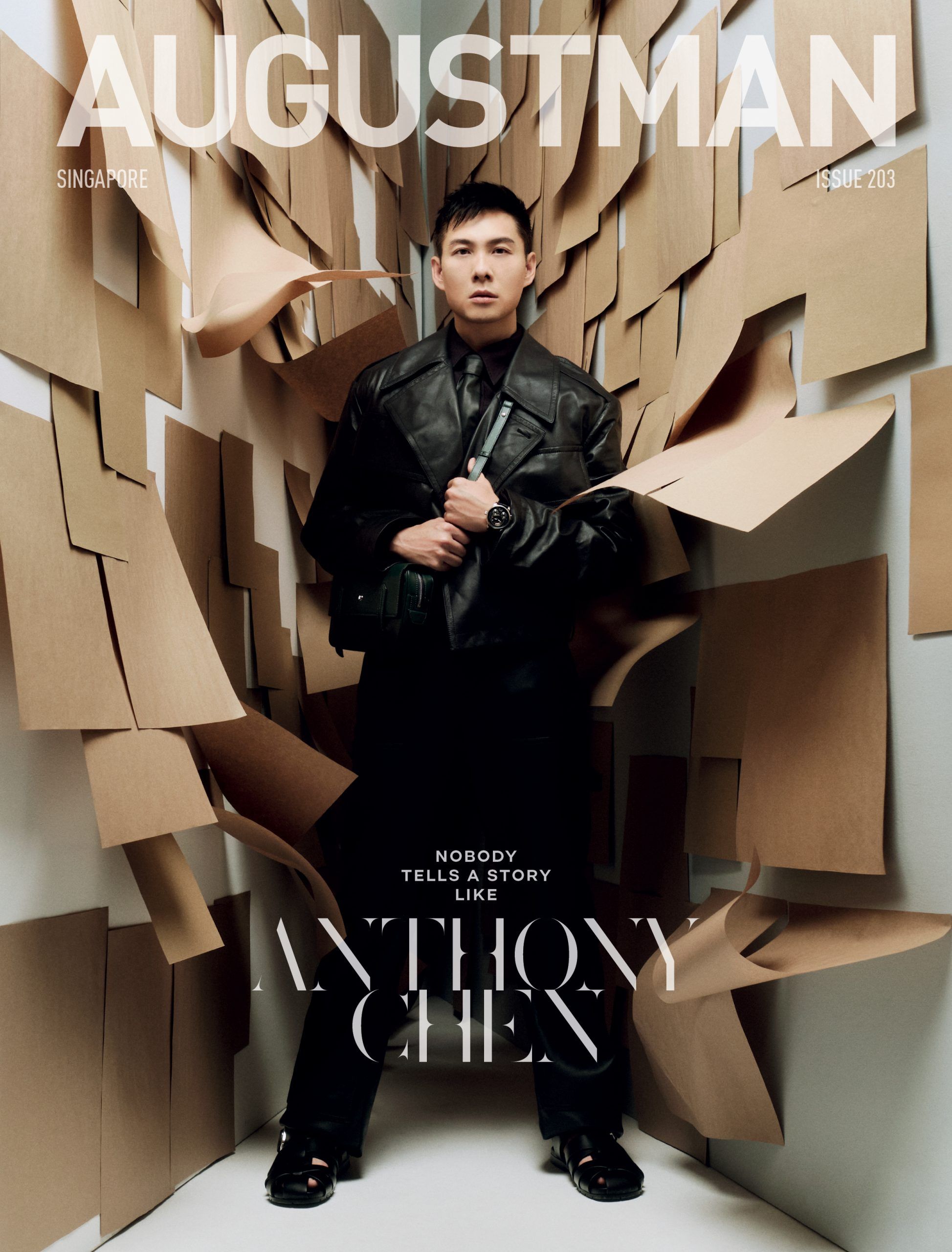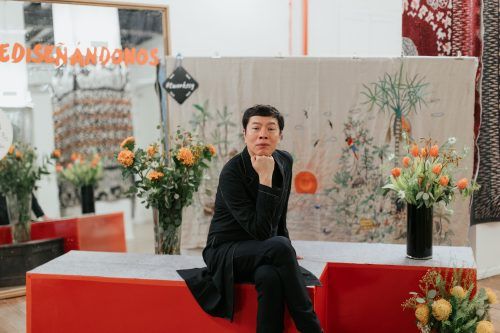A jack of all trades and master of many, that is the man Steve Leung has set out and achieved to be. Being an internationally renowned architect as well as a leading interior and product designer, Leung juggles it all while being the founder of the award-winning Steve Leung Design Group (SLD). SLD has helmed numerous prestigious projects, including One Shenzhen Bay, One Park Shanghai, Shangri-La the Shard, and the new Wilmar HQ right here in Singapore. SLD and Leung have successfully made a mark in the architectural world, being awarded the World’s No.1 Residential Design Firm by Interior Design Top 100 Giants from 2016 to 2020, and the Andrew Martin International Interior Designer of the Year Award 2015 — what most would know as the Oscars of the design world.
Above all that, Steve Leung is a creative that centres his works around people, be it his clients or loved ones. Drawing inspiration from people and adopting it into his philosophy, thus is the creative thinking process of Steve Leung.
How has your upbringing influenced your creative choices in architecture and interior design?
I always knew I would be an architect and this epiphany came to me as early as aged ten. It was my uncle who inspired me, a professional architect himself. I adored watching him draw and sketch late into the night while I was growing up.
I would say my parents have been the biggest mentors in my life. My mother and father both taught me to pursue the quality of life, rather than chasing social status or money. Growing up, my family did not have too much wealth or assets; however, I was encouraged to appreciate and savour the finest things life could offer. Despite working in the post office, my father was keen to take us to remarkable places like The Peninsula Hotel on weekends to enjoy afternoon tea together. This important lesson stuck with me until today: all my works are pervaded by a sense of enjoyment and playfulness, which naturally led to the inception of my personal motto “Enjoy Life, Enjoy Design”.
Walk us through your design process: how is it like to be a designer?
Beyond the client’s brief, I always keep in mind what the values of “good design” mean to me: human-centred — with a balanced mix of aesthetics and functionality — crafted to serve people in the best way possible, by tackling today’s societal and environmental issues and enhancing the quality of living.
After the brief, I would carefully analyse the client’s requests, followed by a meticulous consideration of the project positioning, geographical location, target users, and the specific space’s features. These fundamental steps allow me to identify the best solutions to maximise the advantages and minimise the weak points of each project. I believe a designer should start his creative process with a logical understanding of the project at large; it is crucial to be fully aware about a client’s needs, while balancing the limitations and strengths. Constant attention to detail is also another key attribute for good project management, and this is true for every stage of the design process: from scheme design, development, production, material sourcing, furnishing, to construction supervision.
Your designs exude simple elegance. Would you consider yourself a minimalist designer? Why?
I indeed prefer a design that is contemporary, clean, and simple. However, I have never liked black and white labels – such as being a “minimalist”. I feel that such definitions tend to limit your own creativity and curiosity.
Rather than identifying my design aesthetics with a precise “trend”, I see design as a direct reflection of my own approach to life; my philosophy, if may. I always say that the most important word in my design philosophy is to be appropriate: to do the right thing at the right time within the right context. Only then would everything come together. If you do the right thing, but not at the right time, the result will not be as desired.
The philosophy of your design, the Golden Mean, is a study on human philosophy. Why choose this as the centre of your creative process?
I find this approach to be most accurate in my own definition of “good design”, which always aims towards an “appropriate” balance between aesthetic and functionality. In order to materialise such a design vision, it felt natural for me to rely upon my own cultural roots and background. I strive for a human-centred (以人為本) design that perfectly combines aesthetics and functionality to serve people in the best way possible, with a special attention towards an ancient Chinese philosophy referred to as “The Golden Mean” (中庸之道) – roughly translated as the “beauty of moderation between two spectrums”.
The harmony between human and nature (天人合一) is another key element that I take into consideration every time I can – a tendency fuelled by being born and raised in Hong Kong, where a densely populated urban landscape blends seamlessly with the still serenity of the lush natural surroundings. Drawing inspiration from Asian culture, I always refer and combine these macro concepts within my architectural, interior and product designs.




On the topic of people, how has the pandemic shifted the perception of architectural designs as well as influenced your creative process?
City living and urban commuting have showcased how design can have a positive impact on our daily life. Work-from-home policies that were widely applied worldwide continue to be relevant and are still considered a default in many urban cities. In terms of design, creating dedicated work spaces within our houses to replace traditional office settings has become a status quo, and will continue in this regard. I foresee an even higher degree of customisation in our living spaces, enhanced by the employment of smart technologies. It will change the way we conceive design by unfolding new opportunities on how we approach our usual working experience and habits from our own homes.
What inspired the curation of your latest project Club C+ with your son, and what was the vision when you were designing Club C+?
I would say Club C+ has somehow been conceived because and thanks to the pandemic. With my business schedule being slowed down amid the social and travel restrictions, I had the fantastic opportunity to spend much more time with my family. This local project has given my son Nicholas and I time to bond, support and cherish each other. I absolutely loved working with my son to shape together our first ever social lounge in Hong Kong, and as a father and business mentor, I am proud to see how far Nicholas has come with the curation of Club C+.
We both share interests in exquisite cuisine and wines, rare cigars and art pieces. It did not take us long to realise that we could not find such a suitable setting in Hong Kong where we could enjoy all these pleasures together at the same time within the same venue. This promising market gap inspired us to explore new opportunities in the hospitality and entertainment scene in Hong Kong. Thus was born Club C+, an exclusive and refined “home away from home”, lifestyle destination to savour the best pleasures life could offer. It subtly recalls the hidden meaning of “private home” in Chinese, emphasising the secluded privacy and utmost comfort where luxury connoisseurs can indulge and bond over traditional Cantonese delicacies, fine wines, premier cigars, and exceptional artworks.
Its design concept is quite unique in its genre. Contrary to the majority of private clubs in Hong Kong that still embrace a rather old-school and traditional British design, Club C+ blends Chinese contemporary elements with British accents in an integrated design approach to craft a speakeasy-inspired venue exuding a sophisticated flair.
Wanting it to be an avenue to celebrate different artists, we thus collaborated with well-known Hong Kong-based artists. Club C+’s logo, for example, was conceived by branding maestro Alan Chan. Tino Kwan — among the world’s most celebrated lighting design masters, helped to endow Club C+ with vivid shades and accentuated personality through his exquisite bespoke lighting arrangements. The space is further enriched with delicate floral compositions carefully handpicked by Gary Kwok — one of Asia’s leading floral designers and an inspiring industry pioneer in Hong Kong. Last but not least, the superb contemporary artwork collection adds a new perspective to the ambience, combining within the venue a truly immersive art gallery that showcases unique pieces from legendary Asian masters, including Lalan, Li Huayi, Zhou Chunya, and Kim Tschang-yeul. All these incredible works have been superbly arranged by Art Curator Katherine Kwai with the aim to infuse a very distinctive sense of artistry within the setting.
Will there be future projects where you collaborate with your loved ones?
Very much so, this is definitely our intention! Nic and I are already exploring how to export Club C+’s design concept to locations outside of Hong Kong. The main idea is to develop a “home away from home” exclusive environment where members can unwind at ease, feeling comfortable and, most importantly, safe.
Our targeted venues would be first in Asia – ideally, Shanghai and in Tokyo, followed by SEA markets. I truly am excited to see how things will unfold over the next few years!
Aside from being an architect and interior designer, you are also a product designer. How does the latter differ from the former?
When you approach architectural and interior projects, you need to be very aware of the bigger picture in terms of geography, specific space, and such. Whereas when it comes to product design, you are allowed to invest all your time and focus towards the meticulous realisation of rather small objects. I also believe that it is extremely crucial to partner with established brands that hold a solid know-how in terms of manufacturing and artisanship, so that your creative efforts are well supported by more pragmatic considerations.




What was it like to work with Visionnaire again?
Nature’s Jewel Box 2022 unveils a new chapter of Nature’s Jewel Box furniture collection launched back in 2015 at Salone del Mobile to celebrate Visionnaire’s 10th Anniversary. At the same time, it also incidentally marks my fifth collaboration with the internationally-acclaimed Italian brand, as a result of a long-established relationship of mutual esteem.
Since its debut seven years ago, NJB design pays homage to Visionnaire’s core values of nature’s celebration and holistic sustainability. These values also resonate deeply with my own vision of shaping human-oriented and nature-inspired design solutions that enable the betterment of the built landscape. Ultimately, NJB objects honour nature’s timeless beauty and strength through the feature of multiple details hinting at natural elements, such as colours, materials, textures, patterns, and so on. The final outcome encompasses a very unique design lexicon that seamlessly blends mine and Visionnaire’s creative DNA.
How do you incorporate the elements of nature into Nature’s Jewel Box and how has the concept grown, alongside its designer?
With this new chapter of Nature’s Jewel Box, I wanted to achieve a design outcome that could unapologetically embrace Visionnaire’s core values of nature’s celebration and holistic sustainability perfectly epitomised by the brand philosophy “Green is the New Luxury”.
The design of NJB 2022 explores the beauty of nature from a new perspective, which is the incredible resilience of trees. Trees have an extraordinary adaptability not only to survive, but to actually thrive and grow magnificently amid different weather conditions and even hostile environments. Through the elegant and comfortable objects designed for NJB 2022 and their organic shapes, earthy colours, and delicate hints of understated luxury, it is my intention to encourage end-users to re-think the natural environment from a fresh perspective and feel re-connected with nature within the built environment.
Sustainability has also been a key element throughout the entire designing process. Starting from using trees’ resilience as a concept to align with NJB’s main theme, to a considerate materials selection, my team and I did our best to fully embrace and dive into a holistic and eco-friendly design approach. Each piece has been deliberately carved in ash wood, an enduring type of wood known among artisans for its great ability to survive and thrive in adverse climate conditions. At the same time, ash wood also endows the collection with a sense of solid sturdiness, without compromising the softness and flexibility of its pieces.
Tell us a part or two of Nature’s Jewel Box that we can introduce to our homes
Nature’s Jewel Box 2022 collection features a contemporary and neat design language. Organic lines enhance each object by emulating different shapes of plants to evocatively suggest a sophisticated balance between luxury living and nature’s harmony. Every furniture item also encompasses a timeless, highly-versatile design that matches with different tastes and styles of interiors seamlessly.
From this collection, I would definitely recommend experiencing the dormeuse of the Deimos family. Subtly hinting at different shapes of plants, its design lexicon is sinuous yet precise, with a beautiful alternation of soft curves of the back with edgy angles of the outer shell, exuding harmony between luxury and natural simplicity. The dormeuse is made in strong ash wood, and it has been thoughtfully designed to be as versatile as possible and match effortlessly with different styles of interiors.
Speaking of nature, what do you think about sustainability in architecture and interior designs? How does one effectively achieve that in pursuit of fine crafts?
To me, design can be such a powerful tool to overcome environmental challenges, for the betterment of our community and planet.
I recently witnessed how the interior industry is becoming more and more dedicated to fully embrace design principles of sustainability and well-being that proactively encourage eco-friendly and holistic lifestyles. By gradually encouraging biophilic and sustainable practices, design is prompting a more widespread employment of natural elements and upcycled materials, reconnecting human beings with nature within the built environments – especially for those living in today’s urban jungles. Design will play a more defined role in dealing with today’s environmental challenges, with green building standards like LEED and WELL already increasingly considered and adopted.






